BUICK CENTURY 1996 Owners Manual
Manufacturer: BUICK, Model Year: 1996, Model line: CENTURY, Model: BUICK CENTURY 1996Pages: 340, PDF Size: 17.61 MB
Page 231 of 340
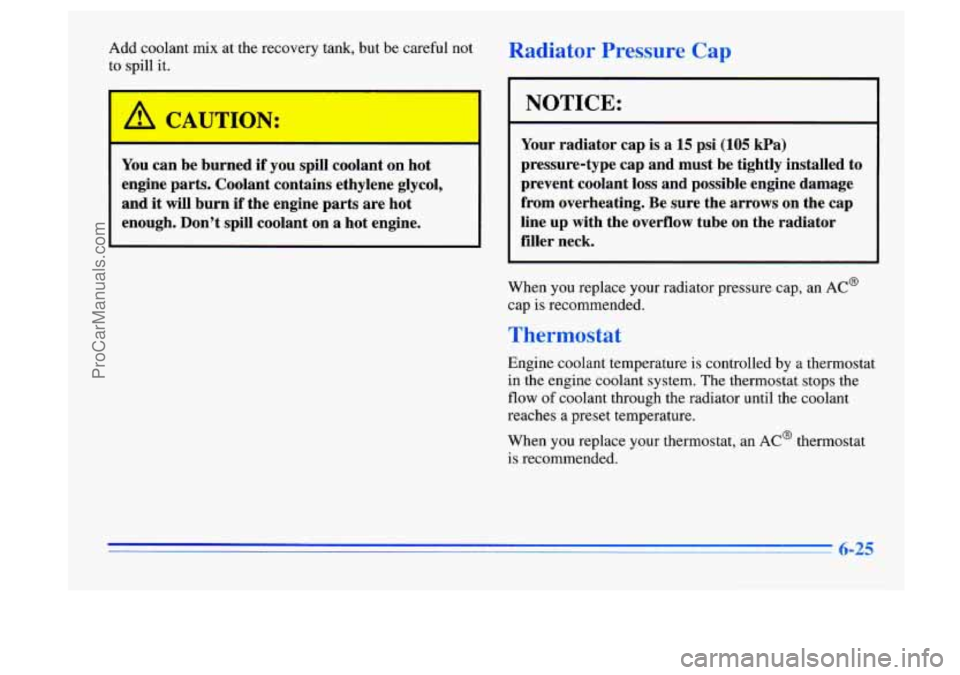
Add coolant mix at the recovery tank, but be careful not
to spill it.
'B CAUTION:
You can be burned if you spill coolant on hot
engine parts. Coolant contains ethylene glycol,
and
it will burn if the engine parts are hot
enough. Don't spill coolant on a hot engine.
Radiator Pressure Cap
NOTICE:
Your radiator cap is a 15 psi (105 kPa)
pressure-type cap and must be tightly installed to
prevent coolant loss and possible engine damage
from overheating. Be sure the arrows on the cap
line up with the overflow tube on the radiator
filler neck.
When you replace your radiator pressure cap, an AC@
cap is recommended.
Thermostat
Engine coolant temperature is controlled by a thermostat
in the engine coolant system. The thermostat stops the
flow of coolant through the radiator until the coolant
reaches a preset temperature.
When you replace your thermostat, an
AC' thermostat
is recommended.
6-25
ProCarManuals.com
Page 232 of 340
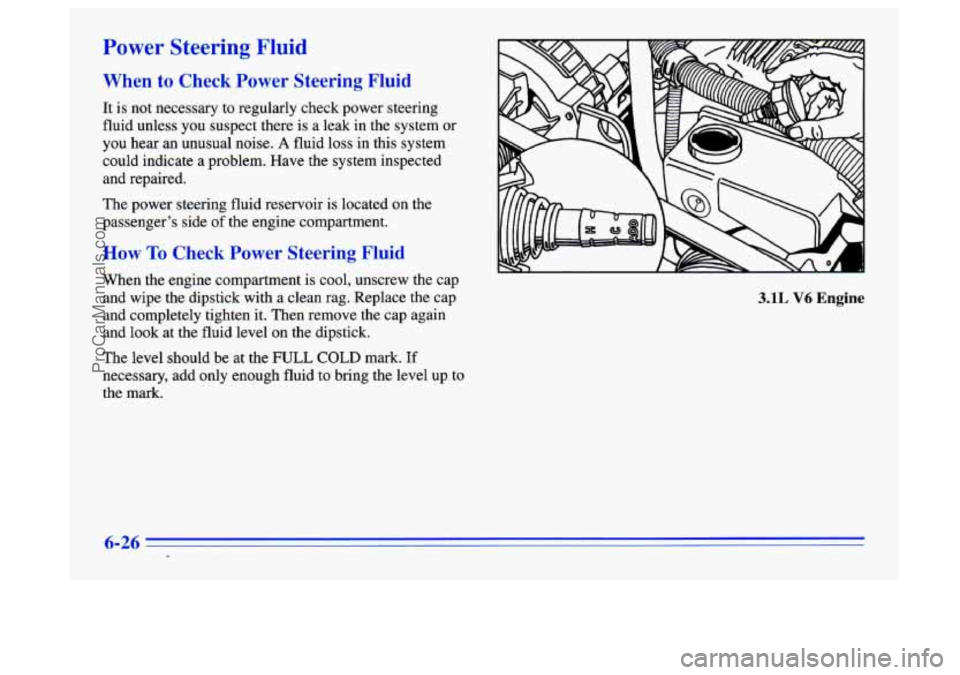
Power Steering Fluid
When to Check Power Steering Fluid
It is not necessary to regularly check power steering
fluid unless
you suspect there is a leak in the system or
you hear an unusual noise. A fluid loss in this system
could indicate a problem. Have the system inspected
and repaired.
The power steering fluid reservoir is located on the
passenger’s side
of the engine compartment.
How To Check Power Steering Fluid
When the engine compartment is cool, unscrew the cap
and wipe the dipstick with
a clean rag. Replace the cap
and completely tighten
it. Then remove the cap again
and look
at the fluid level on the dipstick.
The level should be at the
FULL COLD mark. If
necessary, add only enough fluid to bring the level up to
the mark.
3.1L V6 Engine
6-26
ProCarManuals.com
Page 233 of 340
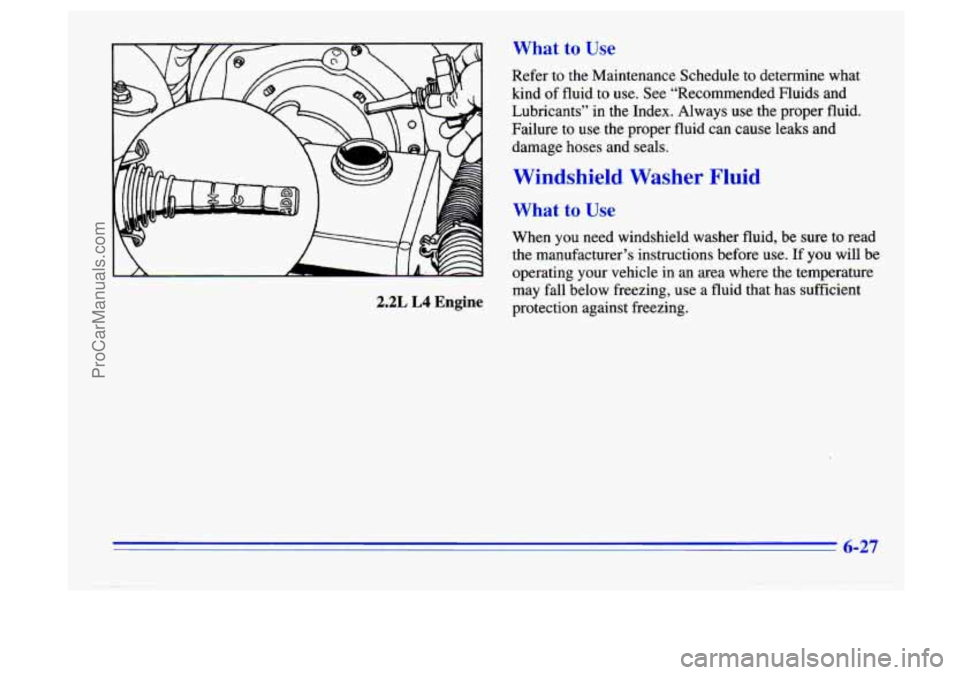
What to Use
2.2L L4 Engine
Refer to the Maintenance Schedule to determine what
kind of fluid to use. See “Recommended Fluids and
Lubricants” in the Index. Always
use the proper fluid.
Failure to use the proper fluid can cause leaks and
damage hoses and seals.
Windshield Washer Fluid
What to Use
When you need windshield washer fluid, be sure to read
the manufacturer’s instructions before use.
If you will be
operating your vehicle in an area where the temperature
may fall below freezing, use a fluid that has sufficient
protection against freezing.
- 6-27
ProCarManuals.com
Page 234 of 340
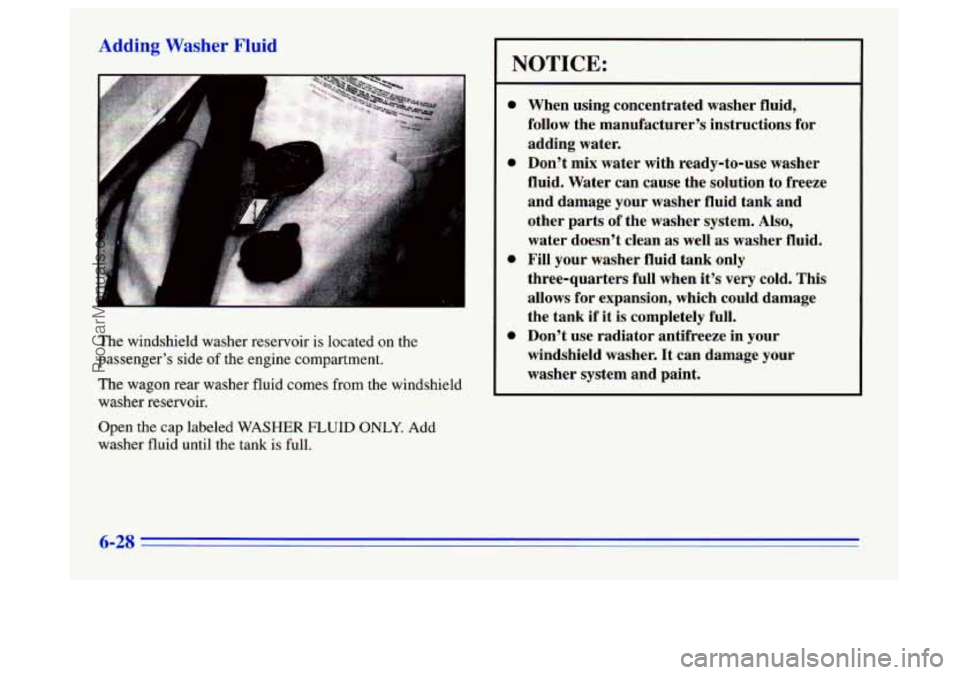
Adc J Washer 1
The windshield washer reservoir is located on the
passenger’s side
of the engine compartment.
The wagon rear washer fluid
comes from the windshield
washer reservoir.
Open the cap labeled
WASHER FLUID ONLY. Add
washer fluid until the tank
is full.
NOTICE:
0
0
0
0
When using concentrated washer fluid,
follow the manufacturer’s instructions for
adding water.
Don’t mix water with ready-to-use washer
fluid. Water can cause the solution to freeze
and damage your washer fluid tank and
other parts of the washer system. Also,
water doesn’t clean
as well as washer fluid.
Fill your washer fluid tank only
three-quarters full when it’s very cold. This
allows for expansion, which could damage
the tank if it is completely full.
Don’t use radiator antifreeze in your
windshield washer. It can damage your
washer system and paint.
6-28
ProCarManuals.com
Page 235 of 340
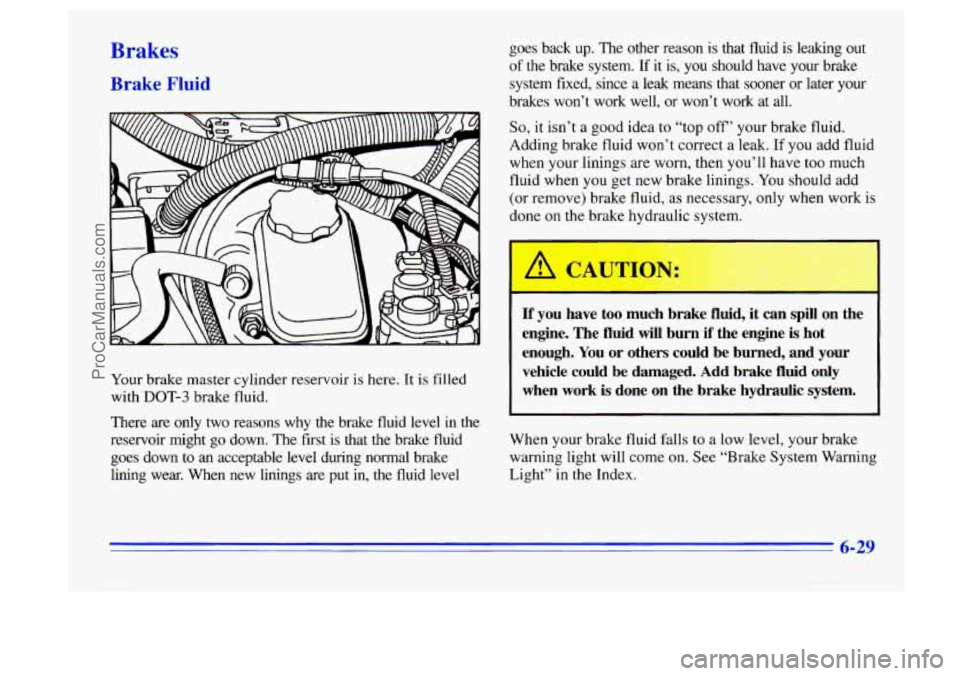
Brakes
Bra
Your brake master cylinder reservoir is here. It is filled
with
DOT-3 brake fluid.
There are
only two reasons why the brake fluid level in the
reservoir might go down. The first is that the brake fluid
goes down to an acceptable level during normal brake
lining wear. When new linings are put in, the fluid level goes
back up. The other reason is that fluid is leaking out
of the brake system. If it is, you should have your brake
system fixed, since a leak means that sooner or later your
brakes won’t work well, or won’t work at all.
So, it isn’t a good idea to “top off’ your brake fluid.
Adding brake fluid won’t correct a leak.
If you add fluid
when your linings are worn, then you’ll have too much
fluid when you get new brake linings.
You should add
(or remove) brake fluid,
as necessary, only when work is
done on the brake hydraulic system.
If you have too much brake fluid, it can spill on the
engine. The fluid
will burn if the engine is hot
enough. You or others could be burned, and your
vehicle could be damaged. Add brake fluid
only
when work is done on the brake hydraulic system.
When your brake fluid falls to a low level, your brake
warning light will come on.
See “Brake System Warning
Light”
in the Index.
ProCarManuals.com
Page 236 of 340
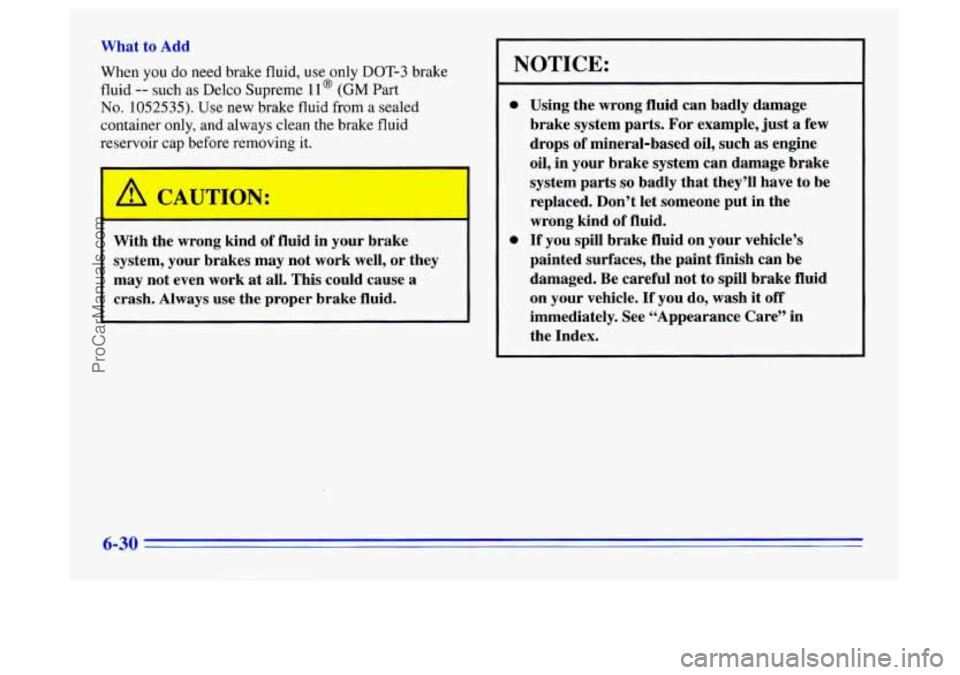
What to Add
When you do need brake fluid, use only DOT-3 brake
fluid -- such as Delco Supreme 11 @ (GM Part
No. 1052535). Use new brake fluid from a sealed
container only, and always clean the brake fluid
reservoir
cap before removing it.
I
I A CAUTION:
With the wrong kind of fluid in your brake
system, your brakes may not work well, or they
may not even work at all. This could cause
a
crash. Always use the proper brake fluid.
NOTICE:
0 Using the wrong fluid can badly damage
brake system parts. For example, just
a few
drops of mineral-based oil, such as engine
oil, in your brake system can damage brake
system parts
so badly that they’ll have to be
replaced. Don’t let someone put in the
wrong kind of fluid.
0 If you spill brake fluid on your vehicle’s
painted surfaces, the paint finish can be
damaged. Be careful not to spill brake fluid
on your vehicle.
If you do, wash it off
immediately. See “Appearance Care’’
in
the Index.
6-30
ProCarManuals.com
Page 237 of 340
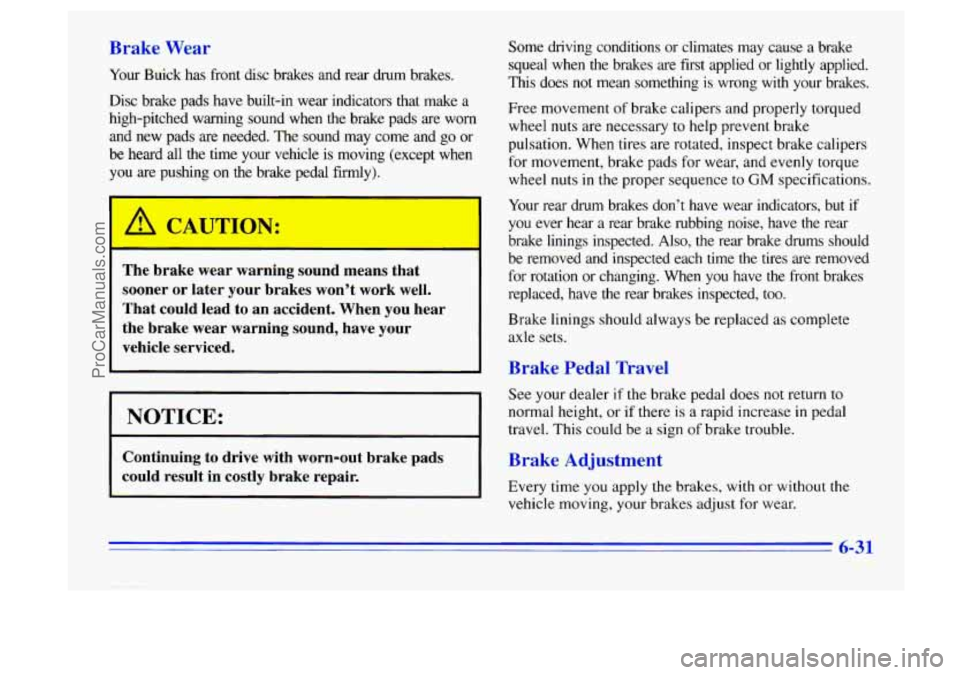
Brake Wear
Your Buick has front disc brakes and rear drum brakes.
Disc brake pads have built-in wear indicators that make a
high-pitched warning sound when the brake pads are worn
and new pads are needed.
The sound may come and go or
be heard all
the time your vehicle is moving (except when
you are pushing on the brake pedal firmly).
A CAUTION:
The brake wear warning sound means that
sooner or later your brakes won’t work well.
That could lead to an accident. When you hear
the brake wear warning sound, have your
vehicle serviced.
NOTICE:
Continuing to drive with worn-out brake pads
could result in costly brake repair.
Some driving conditions or climates may cause a brake
squeal when the brakes are first applied or lightly applied.
This does not mean something
is wrong with your brakes.
Fre’- -1ovement
of brake calipers and properly torqued
wheel nuts are necessary to help prevent brake
pulsation. When tires are rotated, inspect brake calipers
for movement, brake pads for wear, and evenly torque
wheel nuts
in the proper sequence to GM specifications.
Your rear drum brakes don’t have wear indicators, but
if
you ever hear a rear brake rubbing noise, have the rear
brake linings inspected.
Also, the rear brake drums should
be removed and inspected each time the tires are removed
for rotation or changing. When you have the front brakes
replaced, have
the rear brakes inspected, too.
Brake linings should always be replaced as complete
axle sets.
Brake Pedal Travel
See your dealer if the brake pedal does not return to
normal height, or if there is
a rapid increase in pedal
travel. This could be
a sign of brake trouble.
Brake Adjustment
Every time you apply the brakes, with or without the
vehicle moving, your brakes adjust for wear.
6-31
ProCarManuals.com
Page 238 of 340
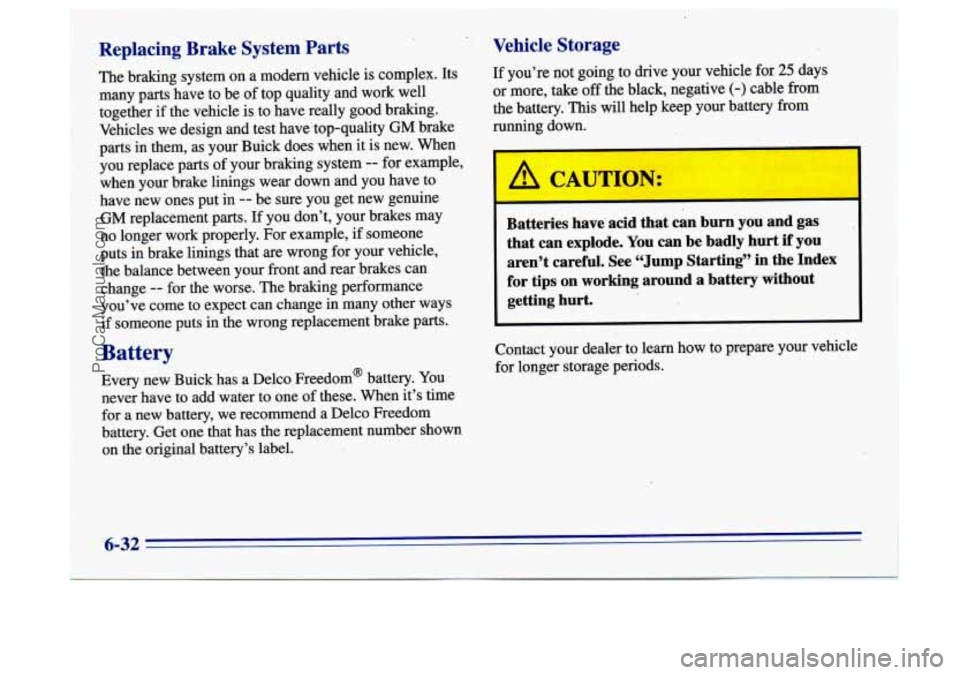
Replacing Brake System Parts
.
Battery
Every new Buick has a Delco Freedom@ battery. You
never have to add water to one
of these. When it's time
for a new battery, we recommend a Delco Freedom
battery. Get one that has the replacement number shown
on the original battery's label.
Vehicle Storage
1
6-32
ProCarManuals.com
Page 239 of 340
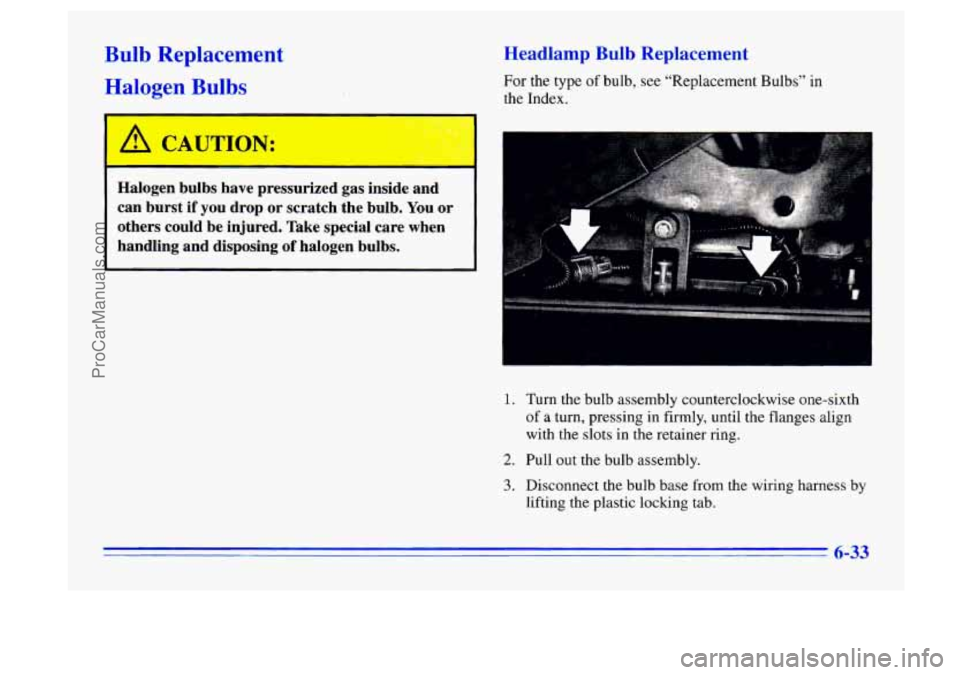
Bulb Replacement
Halpqen BIJhc
Headlamp Bulb Replacement
For the type of bulb, see “Replacement Bulbs” in
the Index.
1 A CAUTION:
Halogen bulb: ave pressu zed gas inside and
can burst if you drop or scratch the bulb.
You or
others could be injured. Take special care when
handling and disposing
of halogen bulbs.
1. Turn the bulb assembly counterclockwise one-sixth
of a turn, pressing in firmly, until the flanges align
with the slots in the retainer ring.
2. Pull out the bulb assembly.
3. Disconnect the bulb base from the wiring harness by
lifting the plastic locking tab.
6-33
ProCarManuals.com
Page 240 of 340
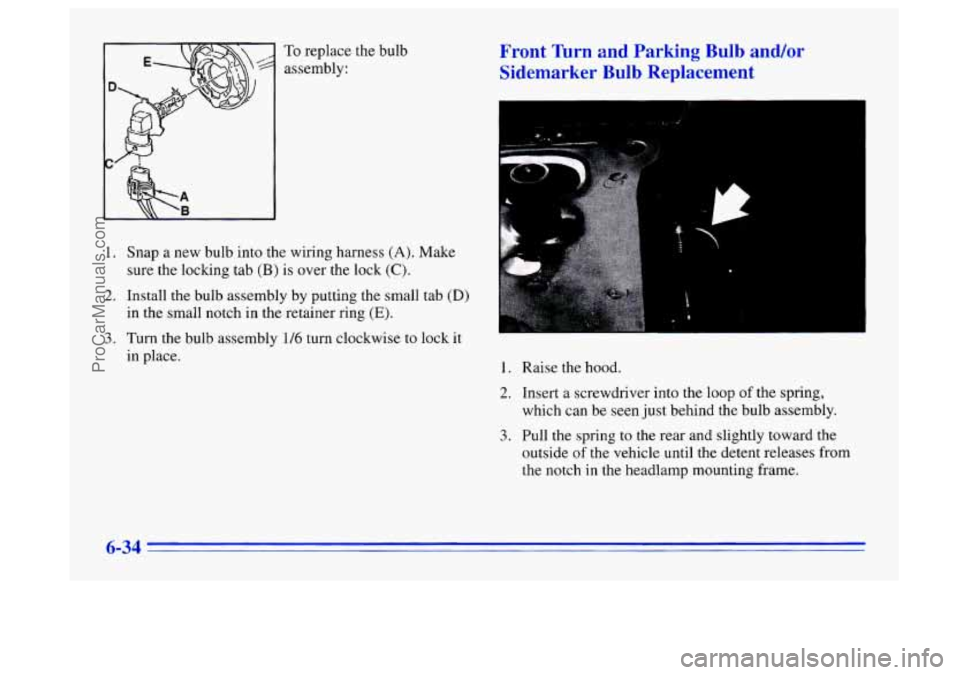
To replace the bulb
assembly:
1. Snap a new bulb into the wiring harness (A). Make
sure the locking tab
(B) is over the lock (C).
2. Install the bulb assembly by putting the small tab (D)
in the small notch in the retainer ring (E).
in place.
3. Turn the bulb assembly 1/6 turn clockwise to lock it
Front lhrn and Parking Bulb and/or
Sidemarker
Bulb Replacement
1. Raise the hood.
2. Insert a screwdriver into the loop of the spring,
which can be seen just behind the bulb assembly.
3. Pull the spring to the rear and slightly toward the
outside
of the vehicle until the detent releases from
the notch in the headlamp mounting frame.
6-34
ProCarManuals.com